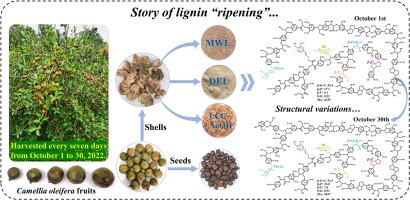International Journal of Biological Macromolecules ( IF 7.7 ) Pub Date : 2023-09-16 , DOI: 10.1016/j.ijbiomac.2023.126946 Xichuang Cheng 1 , Ruxia Ning 1 , Pengfei Li 2 , Fenglun Zhang 3 , Kun Wang 1 , Jianxin Jiang 1

|
Camellia oleifera fruit shell (CFS), a waste lignocellulosic biomass resulting from Camellia oleifera oil production industry, is abundantly available in Southern China. Herein, to understand the structural variations of CFS lignins and lignin-carbohydrate complexes (LCC) during ripening, the native lignin and LCC fractions from CFS (harvested every seven days from October 1 to 30, 2022) were isolated and characterized systematically. The molecular weights of both MWL and DEL fractions steadily increased during ripening. CFS lignins contained abundance of β-O-4′ linkages (maximum of 58.6 per 100Ar in DEL-2), and had low S/G ratios (S/G < 0.6). Moreover, the amounts of β-O-4′ linkages in MWL, DEL, and LCC-AcOH fractions increased first and then decreased during ripening. The main lignin-carbohydrate linkages in the LCC-AcOH fractions were benzyl-ether (7.0–9.4 per 100Ar) and phenyl-glycoside (4.5–5.2 per 100Ar) bonds. Based on the quantitative results, the potential structural diagrams of lignins from different ripening stages of CFS were proposed. Additionally, the LCC-AcOH fractions exhibited pronounced antioxidant capacity and were promising as natural antioxidants. The properties and functions of lignin in plant cell walls, as well as its further appreciation, are crucial for the design and selection of feasible pretreatment strategies for the lignocellulosic materials.













































 京公网安备 11010802027423号
京公网安备 11010802027423号